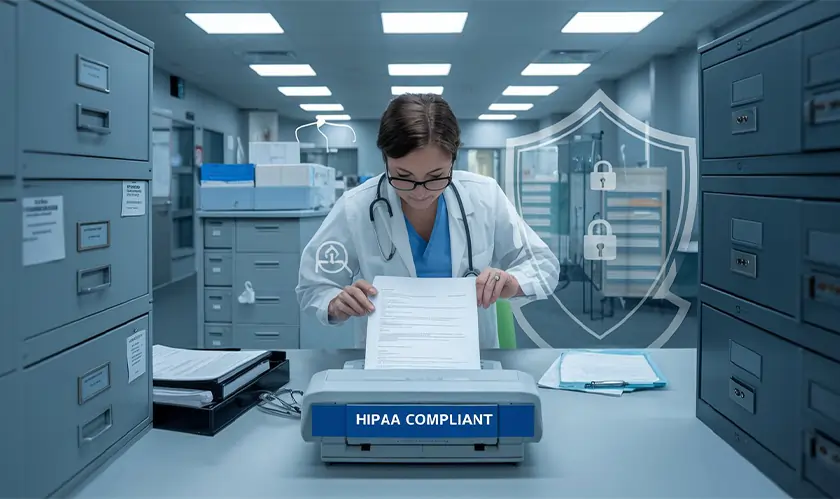Home Industry Healthcare Understanding the Importance o...
Healthcare

CIO Bulletin
29 October, 2024
Healthcare providers and organizations are legally bound to protect patient information through rigorous standards of privacy and security. The Health Insurance Portability and Accountability Act (HIPAA) plays a critical role in establishing these standards, particularly in the transmission of medical information. Faxing remains a prevalent method of sending health documents despite advancing digital technologies. Consequently, understanding HIPAA's requirements and ensuring compliance when faxing medical documents is not just a legal obligation but also an ethical one. In this article, we delve into the intricacies of HIPAA fax compliance and its significance in healthcare communication.
Understanding HIPAA and Its Role in Protecting Patient Information
The Health Insurance Portability and Accountability Act, known as HIPAA, is a federal statute that sets standards for the protection of sensitive patient health information. Established in 1996, HIPAA requires healthcare providers, plans, and clearinghouses to maintain the privacy and security of protected health information (PHI). This includes ensuring that any transmission or sharing of PHI is done in a way that mitigates the risk of unauthorized disclosure.
HIPAA's Privacy Rule establishes national standards for the protection of individual medical records and other personal health information, while the Security Rule sets standards for securing electronic PHI. Compliance with these rules is essential for maintaining trust between patients and healthcare providers, and it helps avoid potential legal penalties.
Faxing medical documents poses specific challenges because faxes may inadvertently be sent to the wrong recipient or left unsecured at the receiving end. HIPAA sets forth regulations that must be met regardless of the method of transmission. Therefore, the process must safeguard PHI to remain compliant.
The Risks of Non-Compliance with HIPAA in Faxing Medical Documents
Non-compliance with HIPAA can lead to significant risks, both for patients and healthcare providers. When patient information is mishandled or disclosed improperly, it can result in a breach of privacy that damages the patient-provider relationship and potentially exposes patients to identity theft and fraud.
For healthcare organizations, the ramifications of non-compliance can be extensive. Not only can it lead to a loss of patient trust, but there can also be substantial financial penalties. Federal regulators may impose fines that can reach millions of dollars, depending on the severity and duration of the violation.
Beyond financial losses, HIPAA violations can damage an organization's reputation, which is often hard to rebuild. This can result in a loss of business as patients may choose to seek care elsewhere. Additionally, in cases of significant non-compliance, criminal charges can be brought against responsible parties, leading to further legal complications.
Secure Faxing Solutions and HIPAA: Ensuring Privacy and Security
Technological advancements have provided solutions that align traditional faxing with HIPAA compliance requirements. Secure fax services offer enhanced features such as encryption, which ensures that PHI remains protected during its transmission over telephone lines.
Additionally, secure faxing solutions often include tracking capabilities which help maintain an audit trail of all sent and received faxes. This feature is critical for compliance since it can prove that the necessary safeguards were in place in the event of an audit or investigation.
Healthcare providers should ensure they are using fax services that are explicitly designed with HIPAA compliance in mind. Choosing the right service provider can make a difference, as dedicated fax solutions will include necessary features such as secure document storage and controlled access to sensitive information.
Training staff on the use of secure fax solutions is also vital. Employees must understand their role in maintaining compliance and the correct procedures for sending and receiving PHI via fax. With proper training, technology can effectively mitigate risks associated with faxing sensitive patient information.
Best Practices for HIPAA Compliant Faxing in Healthcare Settings
To ensure HIPAA compliance when faxing medical documents, healthcare settings should institute a series of best practices. Initially, staff should be trained on what constitutes PHI and the importance of handling this information securely. Clear guidelines on the proper use of fax machines and secure fax services are essential.
Incorporating double-checking procedures before sending faxes can help prevent accidental breaches. This involves verifying the recipient's fax number and confirming the recipient's identity before releasing any sensitive information.
Secure storage and timely destruction of faxed documents containing PHI are also necessary. Once the intended recipient has confirmed receipt of a fax, any physical copies should be stored in a secure location, and subsequently be disposed of in compliance with HIPAA's document destruction policies.
Altogether, staying HIPAA compliant in faxing medical documents is not merely a legal necessity but a cornerstone of patient care. Overall, by understanding both the technological and legal frameworks necessary for secure faxing, healthcare providers can maintain the confidentiality and integrity of patient health information, fostering a safer healthcare environment for all.







